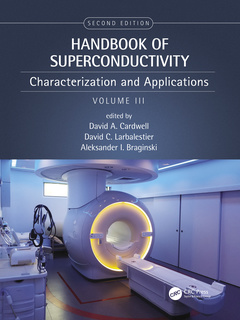Description
Handbook of Superconductivity (2nd Ed.)
Characterization and Applications, Volume Three
Language: English
Subjects for Handbook of Superconductivity:
Keywords
Fault Current Limiters; YBCO Film; Cuprate Superconductors; Critical Current Density; Dc Superconducting QUantum Interference Device; JJ; HTS Material; Flux Pinning; Kinetic Inductance; Superconducting Magnets; Flux Line; Superconducting Materials; Iron Based Superconductor; Josephson Effects; Transition Edge Sensors; High Temperature Cuprate Superconductors; Squid System; AC Loss; Critical State Model; Squid Sensor; Superconducting Wire; Hall Probe; CuO Chain; Vortex Lattice; YBCO Superconductor
· 21x28 cm · Hardback
Description
/li>Contents
/li>Biography
/li>
This is the last of three volumes of the extensively revised and updated second edition of the Handbook of Superconductivity. The past twenty years have seen rapid progress in superconducting materials, which exhibit one of the most remarkable physical states of matter ever to be discovered. Superconductivity brings quantum mechanics to the scale of the everyday world. Viable applications of superconductors rely fundamentally on an understanding of these intriguing phenomena and the availability of a range of materials with bespoke properties to meet practical needs.
While the first volume covers fundamentals and various classes of materials, the second addresses processing of these into various shapes and configurations needed for applications, and ends with chapters on refrigeration methods necessary to attain the superconducting state and the desired performance. This third volume starts with a wide range of methods permitting one to characterize both the materials and various end products of processing. Subsequently, diverse classes of both large scale and electronic applications are described. Volume 3 ends with a glossary relevant to all three volumes.
Key Features:
- Covers the depth and breadth of the field
- Includes contributions from leading academics and industry professionals across the world
- Provides hands-on familiarity with the characterization methods and offers descriptions of representative examples of practical applications
A comprehensive reference, the handbook is suitable for both graduate students and practitioners in experimental physics, materials science, and multiple engineering disciplines, including electronic and electrical, chemical, mechanical, metallurgy and others.
Foreword. Preface. Acknowledgements. Editors-in-Chief. Contributors. Part G Characterization and Modelling Techniques. G1 Introduction to Section G1: Structure/Microstructure. G1.1 X-Ray Studies: Chemical Crystallography. G1.2 X-Ray Studies: Phase Transformations and Microstructure Changes. G1.3 Transmission Electron Microscopy. G1.4 An Introduction to Digital Image Analysis of Superconductors. G1.5 Optical Microscopy. G1.6 Neutron Techniques: Flux-Line Lattice. G2 Introduction to Section G2: Measurement and Interpretation of Electromagnetic Properties. G2.1 Electromagnetic Properties of Superconductors. G2.2 Numerical Models of the Electromagnetic Behavior of Superconductors. G2.3 DC Transport Critical Currents. G2.4 Characterisation of the Transport Critical Current Density for Conductor Applications. G2.5 Magnetic Measurements of Critical Current Density, Pinning, and Flux Creep. G2.6 AC Susceptibility. G2.7 AC Losses in Superconducting Materials, Wires, and Tapes. G2.8 Characterization of Superconductor Magnetic Properties in Crossed Magnetic Fields. G2.9 Microwave Impedance. G2.10 Local Probes of Magnetic Field Distribution. G2.11 Some Unusual and Systematic Properties of Hole-Doped Cuprates in the Normal and Superconducting States. G3 Introduction to Section G3: Thermal, Mechanical, and Other Properties. G3.1 Thermal Properties: Specific Heat. G3.2 Thermal Properties: Thermal Conductivity. G3.3 Thermal Properties: Thermal Expansion. G3.4 Mechanical Properties. G3.5 Magneto-Optical Characterization Techniques. Part H Applications. H1 Introduction to Large Scale Applications. H1.1 Electromagnet Fundamentals. H1.2 Superconducting Magnet Design. H1.3 MRI Magnets. H1.4 High-Temperature Superconducting Current Leads. H1.5 Cables. H1.6 AC and DC Power Transmission. H1.7 Fault-Current Limiters. H1.8 Energy Storage. H1.9 Transformers. H1.10 Electrical Machines Using HTS Conductors. H1.11 Electrical Machines Using Bulk HTS. H1.12 Homopolar Motors. H1.13 Magnetic Separation. H1.14 Superconducting Radiofrequency Cavities. H2 Introduction to Section H2: High-Frequency Devices. H2.1 Microwave Resonators and Filters. H2.2 Transmission Lines. H2.3 Antennae. H3 Introduction to Section H3: Josephson Junction Devices. H3.1 Josephson Effects. H3.2 SQUIDs. H3.3 Biomagnetism. H3.4 Nondestructive Evaluation. H3.5 Digital Electronics. H3.6 Superconducting Analog-to-Digital Converters. H3.7 Superconducting Qubits. H4 Introduction to Radiation and Particle Detectors that Use Superconductivity. H4.1 Superconducting Tunnel Junction Radiation Detectors. H4.2 Transition-Edge Sensors. H4.3 Superconducting Materials for Microwave Kinetic Inductance Detectors. H4.4 Metallic Magnetic Calorimeters. H4.5 Optical Detectors and Sensors. H4.6 Low-Noise Superconducting Mixers for the Terahertz Frequency Range. H4.7 Applications: Metrology. Glossary. Index.




